Operations with Whole Numbers
Addition
Definition Addition
Addition is the process of combining two or more numbers to find their total. When we add, we join together \(\textcolor{colordef}{\text{part 1}}\) and \(\textcolor{colorprop}{\text{part 2}}\) to get the \(\textcolor{olive}{\text{total}}\).$$\textcolor{colordef}{\text{part 1}} + \textcolor{colorprop}{\text{part 2}} = \textcolor{olive}{\text{total}}$$

- The \(+\) symbol is called the plus sign. It tells us to add the numbers together.
- The \(=\) symbol is the equals sign. It shows that the numbers on both sides are the same.
- Numbers: $$\textcolor{colordef}{7} + \textcolor{colorprop}{5} = \textcolor{olive}{12}$$
- Items:
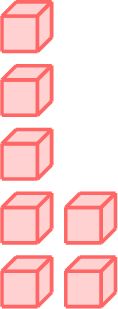 \(+\)
\(+\)  \(=\)
\(=\) 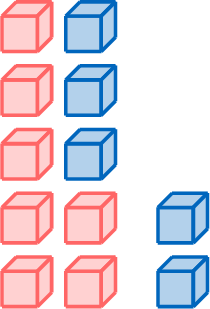
- Word form:
\(\textcolor{colordef}{\text{seven}}\) plus \(\textcolor{colorprop}{\text{five}}\) equals \(\textcolor{olive}{\text{twelve}}\)
Method Column addition
When we add larger numbers, we write them in columns with their place values aligned. Then, we add each column from right to left.
Example
Calculate \(189+784\)
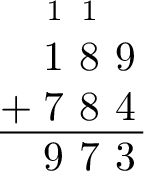
Subtraction
Definition Subtraction
Subtraction is the process of taking away one number from another to find the difference. The \(-\) symbol is called the minus sign. It tells us to take one number away from another.
Subtraction can be shown in several ways:
Subtraction can be shown in several ways:
- Numbers: $$\textcolor{olive}{32} - \textcolor{colordef}{14} = \textcolor{colorprop}{18}$$
- Visual (Items):
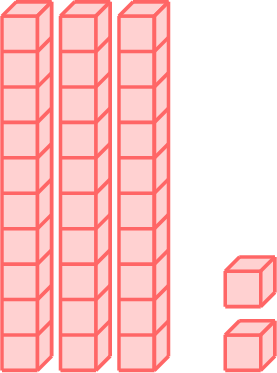 \(-\)
\(-\) 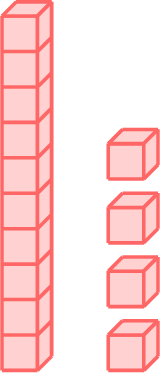 \(=\)
\(=\) 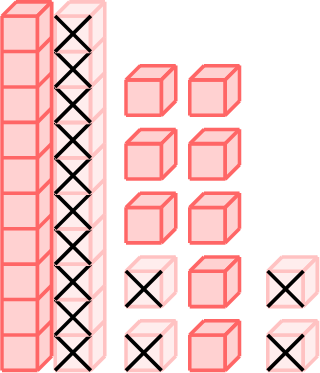
- Words:
thirty-two minus fourteen equals eighteen
Method Column subtraction
When subtracting larger numbers, write them in columns with the digits aligned by place value. Then subtract each column from right to left.
Example
Calculate \(784 - 189\)
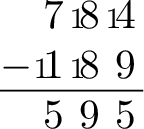
Multiplication
Definition Multiplication
Multiplication is the process of repeated addition. When we multiply, we add a number to itself a certain number of times. The \(\times\) symbol (or "times sign") tells us to multiply the numbers.
Multiplication can be represented in several ways:
Multiplication can be represented in several ways:
- Numbers: $$\textcolor{colordef}{4} \times \textcolor{colorprop}{3} = \textcolor{olive}{12}$$
- Groups:
\(\textcolor{colordef}{4}\) groups of \(\textcolor{colorprop}{3}\) equals \(\textcolor{olive}{12}\) - Repeated addition: $$\textcolor{colorprop}{3}+\textcolor{colorprop}{3}+\textcolor{colorprop}{3}+\textcolor{colorprop}{3} = \textcolor{olive}{12}$$
- Words:
\(\textcolor{colordef}{\text{four}}\) times \(\textcolor{colorprop}{\text{three}}\) equals \(\textcolor{olive}{\text{twelve}}\) - Visual (Items):
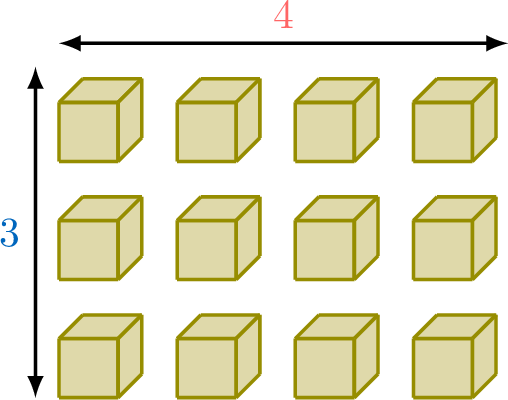
- Part-whole model:
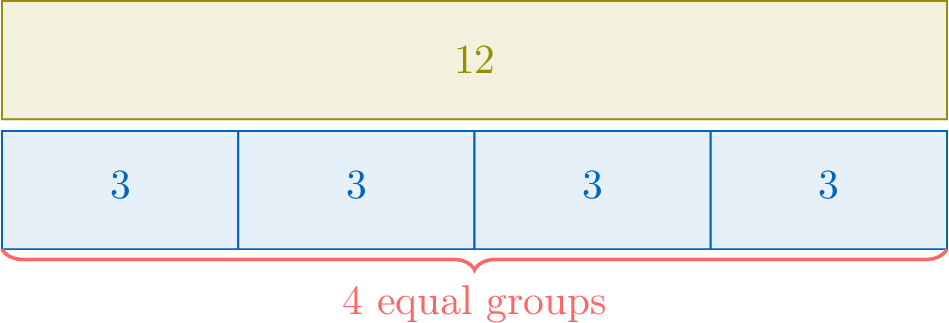
Method Column multiplication
When multiplying larger numbers, write the numbers in columns so the digits align. Multiply the first number by each digit of the second number (starting from the right), then add the results.
Example
Calculate \(123 \times 21\)
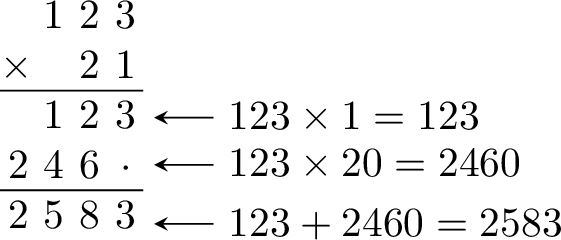
Division
Definition Division
Division is the process of splitting a number into equal parts. In a division expression, the number being divided is called the dividend, and the number you divide by is the divisor. The result is the quotient. The \(\div\) symbol is the division sign.$$\textcolor{olive}{\text{Dividend}} \div \textcolor{colordef}{\text{Divisor}} = \textcolor{colorprop}{\text{Quotient}}$$Division can be represented in several ways:
- Numbers: $$\textcolor{olive}{6}\div \textcolor{colordef}{3}=\textcolor{colorprop}{2}$$
- Words:
six divided by three equals two - Items:
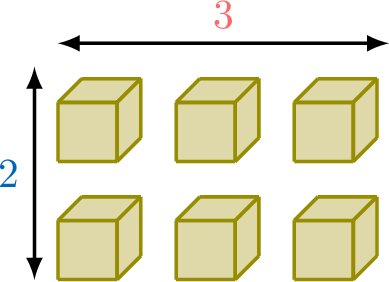
Definition Division with Remainder
Sometimes a number does not divide evenly. The number left over is called the \(\textcolor{orange}{\text{remainder}}\).$$\textcolor{olive}{13} \div \textcolor{colordef}{3} = \divionRemainder{\textcolor{colorprop}{4}}{\textcolor{orange}{1}}$$This relationship can also be written as:$$\textcolor{olive}{13} = \textcolor{colordef}{3} \times \textcolor{colorprop}{4} + \textcolor{orange}{1}$$where \(\textcolor{olive}{13}\) is the dividend, \(\textcolor{colordef}{3}\) is the divisor, \(\textcolor{colorprop}{4}\) is the quotient, and \(\textcolor{orange}{1}\) is the \(\textcolor{orange}{\text{remainder}}\).
The long division algorithm shows how we can compute division step by step.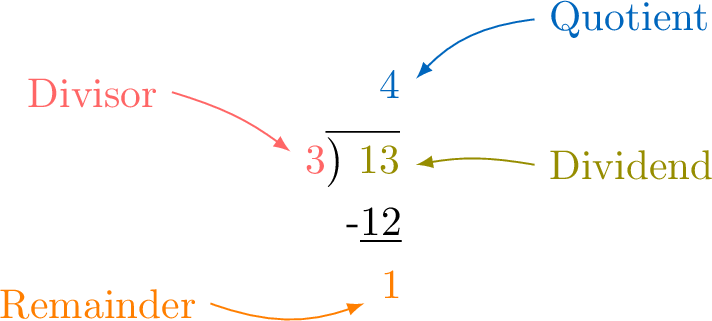
The long division algorithm shows how we can compute division step by step.

Method Long division
When dividing larger numbers, we work digit by digit, starting from the left. If a digit (or group of digits) is too small to be divided by the divisor, we bring down the next digit.
Example
Calculate \(125 \div 4\)
Using long division,

Order of Operations
Definition Order of operations
The order of operations tells us the sequence in which to perform different operations in a calculation:
- Parentheses (or brackets)
- Multiplication and Division (from left to right)
- Addition and Subtraction (from left to right)
Example
Calculate \(4 + 2 \times 3\)
$$\begin{aligned}[t]4+2 \times 3 & = 4 +6&&\text{(evaluate the multiplication } 2 \times 3=6)\\& = 10&&(\text{evaluate the addition } 4 +6=10)&\end{aligned}$$
Solving Problems
Method Solve problems
To solve a word problem:
- Read and understand the problem.
- Identify the steps needed to solve it.
- Write the mathematical expression.
- Evaluate the expression.
- Conclude and check your answer.
Example
If you have 5 apples, buy 4 more, then give away 2, how many apples do you have left?
- Read: Notice that buying means addition and giving away means subtraction.
- Identify the steps:
- Start with 5 apples.
- Add 4 apples.
- Subtract 2 apples.
- Write the expression: \((5+4)-2\)
- Evaluate the expression: $$ \begin{aligned}[t](5+4)-2&=9-2\\&=7\\\end{aligned}. $$
- Conclude: You have 7 apples left.